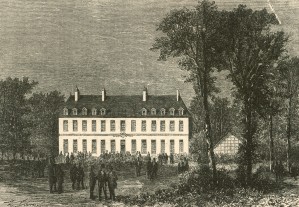
On August 11, 1836 Guizot wrote to his daughter Henriette “Tomorrow, as soon as I rise, I shall go to see a little estate three leagues from Lisieux that I have been told is for sale. The house is a former abbey, large, well built and in quite good repair. There are beautiful woods all around it, a spring on one side of the house and a fast stream running through the meadows. The estate is called Val-Richer”.
 Although he had been a Deputy for Lisieux since 1830, Guizot had taken a long time to settle in his constituency. He also wanted to settle in a family home where he could live with his four children. François, the eldest, was 21 years old and would be capable of looking after it. The estate is located in the borough of Pont l’Evêque, the canton of Cambremer and the town of Saint-Ouen-le-Pin. The Cistercian Abbey was founded by Nivard, the brother of Saint Bernard, and Thomas Becket had probably stayed there in 1170. But only the abbot’s residence remained, which had been rebuilt in the middle of the XVIIIth century and was in need of renovation. Guizot bought it, with its 175 hectares of land and woods, for 85,000 francs.
Although he had been a Deputy for Lisieux since 1830, Guizot had taken a long time to settle in his constituency. He also wanted to settle in a family home where he could live with his four children. François, the eldest, was 21 years old and would be capable of looking after it. The estate is located in the borough of Pont l’Evêque, the canton of Cambremer and the town of Saint-Ouen-le-Pin. The Cistercian Abbey was founded by Nivard, the brother of Saint Bernard, and Thomas Becket had probably stayed there in 1170. But only the abbot’s residence remained, which had been rebuilt in the middle of the XVIIIth century and was in need of renovation. Guizot bought it, with its 175 hectares of land and woods, for 85,000 francs.
For ten years, with the help of his sister-in-law Aline de Meulan, he spent most of his modest income on renovating and embellishing the house and the garden. He became very interested in trees, especially fruit trees, flowers and water features. In 1840, he wrote “I would like Val-Richer to become famous for its flowers through its abundance of roses and dahlias, and for the excellence of its fruit through the cherries and apples”. He naturally took great pains to install his vast library in the corridor on the first floor, at the end of which was his study whose walls were slowly filled with portraits of his loved-ones, and his little bedroom of almost monastic, or Calvinist, simplicity.
On the pediment of the inner courtyard, Guizot’s motto Omnium recta brevissima (the straight road is always the shortest) can be seen. It is also on his ministerial portfolio and suits him well. Guizot was happy in this busy solitude: “I spend a great part of the day observing nature around me, and I feel myself becoming as peaceful as it is. This place is really beautiful – a pleasant and wild beauty”.
 From 1849 onwards, Guizot spent more time there, about six months of the year, surrounded by an ever-growing family where he practiced the art of being a grandfather whilst working on his books. In 1855, his daughter Henriette and her husband Conrad de Witt came to live there permanently and managed the estate. In 1854, one of the many visitors told of his impressions: “Val-Richer is a most pleasant place. It is M. Guizot’s retreat according to his ideals of Perfection… A well-ordered life-style, a great flow of ideas, friendly politeness and tranquillity, a charming intellectual oasis in these somewhat rough and ready valleys of Normandy.”
From 1849 onwards, Guizot spent more time there, about six months of the year, surrounded by an ever-growing family where he practiced the art of being a grandfather whilst working on his books. In 1855, his daughter Henriette and her husband Conrad de Witt came to live there permanently and managed the estate. In 1854, one of the many visitors told of his impressions: “Val-Richer is a most pleasant place. It is M. Guizot’s retreat according to his ideals of Perfection… A well-ordered life-style, a great flow of ideas, friendly politeness and tranquillity, a charming intellectual oasis in these somewhat rough and ready valleys of Normandy.”
Val-Richer became well-known in Parisian society circles and abroad, and did become the rallying point for both family and friends that Guizot had so wanted. It is here that he died on September 12, 1874 surrounded by his family. He is buried close by, in the family grave in the Saint-Ouen-le-Pin cemetery, with a few of his close relatives.
